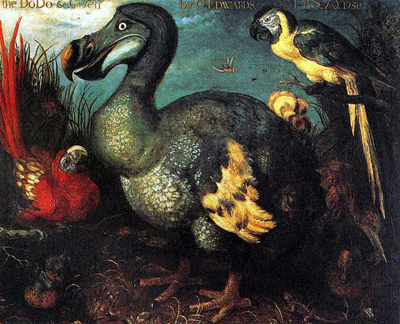
There is now considerable evidence that we are living through the sixth mass extinction and that human activity is the cause. Although human beings will likely survive, they will be living in a world that has dramatically changed, and not for the better. There are already foreboding signs of that change. Significantly, although some of the large-scale extinction is already underway, there’s still a chance to prevent mass extinction.
I will come back to the evidence for the sixth mass extinction currently underway. But first it’s worthwhile to consider a characteristic of past cases, noting that past mass extinctions tended to wipe out the dominant species, leaving a new one in its place. This is a topic that’s been examined in great detail; every schoolchild knows about the demise of the dinosaurs. Following the usual pattern of mass extinction, dinosaurs became the dominant species on Earth for millions of years, before their own extinction.
The extinction of the dinosaurs because of an asteroid that struck Earth is an excellent example of how a scientific hypothesis is confirmed. In 1981 Luis Alvarez, who had already won a Nobel prize in physics, and his geologist son Walter, put forth the thesis that an asteroid had struck Earth, sent up a vast cloud of dust that encircled the globe, blocking out the sun, preventing photosynthesis, and so causing massive loss of life. They calculated that an asteroid 10 kilometers across would produce a crater 100 to 150 kilometers in diameter.
The paper they published drew skepticism because evidence for it was scarce. But as the 1980s progressed, geologists found more and more evidence for an impact. In 1991 the crater itself, measuring 130 kilometers in diameter, was identified on Mexico’s Yucatan peninsula. There are still some skeptics, but the consensus now is that the Alvarez team was right.
The Impact of Human Activity
Two of the major human activities that wiped out other species are hunting and habitat destruction. A couple of examples of the senseless and merciless slaughter of animals have been depicted often enough to become part of popular culture. Victorian age hunting parties killed animals systemically, in a time presumably less enlightened than today. Similarly, historians write of wealthy men — frequently referred to as sportsmen — riding on newly laid-down rails and firing their guns at as much animal life as they could bring down. These practices done in the name of sport, are now largely outlawed. Yet the slaughter of whales, the mutilation of gorillas and similar atrocities, abound.
These examples are anecdotal. To describe extinctions more quantitatively, the established fact that 130 species of birds were driven to extinction by hunting between the years 1500 and 2000 is a starting point. There are about 10,000 species of birds, so their extinctions represent a loss of 1.3 percent of species in 500 years, or 26 extinctions per million species per year. This is much greater than the “normal loss” of species through time. This amount is known as the background rate of extinction estimated to be about one extinction per million species per year.
The loss of 26 extinctions per million species per year is probably an underestimate because many other bird species might have become extinct over that time period without being recorded. When the increasingly important influence of habitat destruction is added, a best estimate comes to about 100 extinctions per million species of birds per year.
We can extend this calculation of bird extinctions to all species. There are an estimated 10 million species of animals on Earth. A reasonable estimate of the total losses among them might be 1000 species per year, or three species every day. Obviously this is a very rough estimate, but it suggests that a sixth mass extinction may be underway.
The oceans, representing about two-thirds of the surface of the planet, are playing a large role in current extinctions. The International Programme on the State of the Ocean (IPSO) convened a panel of experts from different disciplines, such as coral reef ecologists, toxicologists, and fisheries scientists, to assess the status.
A report was just released. It can best be summarized by what one of the panel members told a BBC interviewer: ocean life is “at high risk of entering a phase of extinction of marine species unprecedented in human history.” More specifically, issuses such as over fishing, pollution, and climate change are acting together in ways that haven’t previously been recognized.
Changing Directions
Can the move toward a sixth mass extinction be stopped, or even reversed? Certainly the contribution due to hunting offers the possibility for change. Some of the abuses of the past have been outlawed, others seem so barbaric that no person today with any shred of decency would practice them.
Considering some of the other examples, Japanese hunting of whales can be put to a stop by enforcing rules that already exist. Mutations of gorillas can similarly be stopped through education and law enforcement.
Habitat destruction is quite a different matter. Human beings, as their population grows, take over habitats once used chiefly by animals. This growth of the human population, although slowed and even reversed in some regions, continues on a global scale. And with that continuing growth, the destruction of animal habitats increases.
The sixth mass extinction has a built-in limitation that follows from its chief cause; that is, from expansion of the human population. True, as this population continues to increase and expand, so too will the destruction of animal habitats and the loss of animal species. But eventually the growth of the human population has to stop, as the resources needed to sustain that growth reach a limit.
By the time that limit is reached, enormous damage will have been done. Animal species will be severely diminished. So will plant species, as one component of a degraded environment. The world will seem a barren place to human beings, dominant species though they will be.
